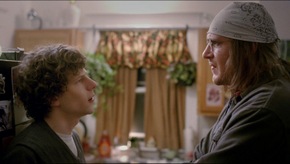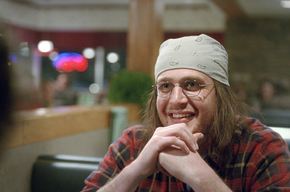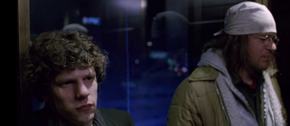 THE END OF THE TOUR
THE END OF THE TOUR
An interviewer for Rolling Stone travels to Bloomington, Illinois, to meet his subject: an author embarking on the last leg of his book tour. They make small talk at the author's house. They smoke incessantly. They gorge on junk food. They travel to Minnesota for a reading and radio segment. They visit the Mall of America. They catch a multiplex movie. They hang out with a couple of young women. They consume more junk food. They return to Bloomington. They part ways.
In broad outline, that is the entire plot of director James Ponsoldt's and screenwriter Donald Margulies' The End of the Tour. And with the possible exception of Mad Max: Fury Road, no other 2015 release, to date, has entertained, thrilled, and devastated me quite as much as this one. (The film is currently playing at Iowa City's Marcus Sycamore Cinema.) I'll concede that much of the reason for my enjoyment might be strictly personal, or at least intensely specific. But I also don't think anyone needs to have been an interviewer, or an interviewee, to be dazzled by the film's intelligence, emotional complexity, and deep empathy, or by the insight it demonstrates regarding the oddly fraught practice of the celebrity profile. You probably also don't need to be an admirer of David Foster Wallace to find yourself frequently moved to tears, but if you are one, consider yourself warned.
Among the late author's legion of fans, I would likely, to many, fall in the namby-pamby category, as I'm one of those people who owns Infinite Jest but hasn't yet built up the will or stamina to read it. But while the 1,079 pages of Wallace's magnum opus continue to stare at me accusingly from my bookshelf, I've tried to alleviate my guilt by instead devouring his shorter nonfiction collections over and over. I've read, for example, A Supposedly Fun Thing I'll Never Do Again and Remember the Lobster in their entirety at least three times each - numerous stories within have been read more than a dozen - and also own the Wallace-read audiobook of Remember the Lobster which, right after his 2008 suicide, played in my car for a good two months. So while I'm clearly not a Wallace completist, I am a devotee, and initially sided with those who worried that The End of the Tour would sully the character of a man whose works felt so emotionally transparent and unguarded that it was like he was writing directly to you, and you alone. (Wallace's widow Karen Green and several of the author's friends have vehemently opposed the film's existence, some having seen it, some not.)
 I'll leave it to those close to him to judge whether Jason Segel, here, enacts the "real" David Foster Wallace. To this viewer's eyes, he does something even more crucial: He absolutely suggests the idea of Wallace, which, as the film makes abundantly clear, is as close to knowing him as we, and Jesse Eisenberg's interviewer David Lipsky, can ever get. The movie is based on Lipsky's 2010 nonfiction Although of Course You End Up Becoming Yourself: A Road Trip with David Foster Wallace, which was published 14 years after its author's travels with Wallace while he promoted Infinite Jest, and is filled with conversational transcriptions from his unpublished interview for Rolling Stone. Yet the book and the film nail the critical paradox of such interviews: Both men know the point of the piece is for readers to "get to know" Wallace, and because both are aware of it, they also know the task is fundamentally meaningless. Wallace can act the role of "subject" just as Lipsky can act the role of "journalist," but what results won't necessarily be truth - it'll be whatever story Lipsky wants it to be. As Wallace tells his End of the Tour interviewer during an early conversation, "David, this is nice. This is not real."
I'll leave it to those close to him to judge whether Jason Segel, here, enacts the "real" David Foster Wallace. To this viewer's eyes, he does something even more crucial: He absolutely suggests the idea of Wallace, which, as the film makes abundantly clear, is as close to knowing him as we, and Jesse Eisenberg's interviewer David Lipsky, can ever get. The movie is based on Lipsky's 2010 nonfiction Although of Course You End Up Becoming Yourself: A Road Trip with David Foster Wallace, which was published 14 years after its author's travels with Wallace while he promoted Infinite Jest, and is filled with conversational transcriptions from his unpublished interview for Rolling Stone. Yet the book and the film nail the critical paradox of such interviews: Both men know the point of the piece is for readers to "get to know" Wallace, and because both are aware of it, they also know the task is fundamentally meaningless. Wallace can act the role of "subject" just as Lipsky can act the role of "journalist," but what results won't necessarily be truth - it'll be whatever story Lipsky wants it to be. As Wallace tells his End of the Tour interviewer during an early conversation, "David, this is nice. This is not real."
Segel's portrayal, consequently, requires him to be cagey even when Wallace is at his most open, and you certainly see that in his physical choices: the reflexive, protective way he folds his arms over his chest; the sidelong glances toward Lipsky's tape recorder, and its threatening red light, every time he shares more than he means to. Yet Segel's phenomenal performance is about far more than surface details; he appears to have burrowed so completely into his interpretation of Wallace that it's almost like you're seeing the familiar comic actor for the very first time. Segel evinces, with no apparent effort, the ingrained curiosity, humor, and wicked smarts we associate with Wallace's literary output, and his evocation of the author's humility is particularly touching and beautiful. (We're given one brief peek at Wallace teaching at Illinois State University, and while his students clearly relish their class time, he still finds it necessary afterward to tell Lipsky, "I'm normally a much better teacher than that, I swear.")
You don't, however, have to know how Wallace's life ended to sense the heartbreaking melancholy that suffuses Segel's depiction. Even at his cheeriest and funniest, and he's frequently cheerful and funny, you watch this Wallace and understand how acutely aware he is that everything he shares with Lipsky - his thoughts on the sadness of modern youth, his ambivalence about fame, his explanation for his suicide attempt - are revelations in a void. The Davids can speak as friends, but they're not friends, and screenwriter Margulies gives Segel extraordinary opportunities to display Wallace's loneliness and ache for real connection, as well as the brief respites he's able to find in such mundane pleasures as cheesburgers, late-night TV, and John Travolta's demise in the action flick Broken Arrow. Wallace's real-life friends and family may find the movie contemptible, and perhaps for very legitimate reasons. But it would be hard to argue that Ponsoldt, Margulies, and particularly Segel haven't honored Wallace with a gorgeously expansive, three-dimensional portrait.
 It's actually Eisenberg's Lipsky who, for most of the movie, is contemptible, but the actor's ferociously brave performance ensures that that's never all he is. Prior to his trek to Bloomington, we see Lipsky at his own book reading for a novel that's being met with, at best, polite indifference, and he's barely able to contain his hostile jealousy when reading Walter Kirn's legendarily glowing review of Infinite Jest in New York magazine. (Lipsky angrily exclaims "What the f---?!" before reaching the end of the review's first paragraph.) So it's pretty evident that Lipsky has at least a partially unbecoming agenda when he sets off for his interview. And if you have fond feelings for Wallace, you might find everything about Lipsky nauseating from the start: his forced attempts at being ingratiating; his '30s-tough-guy puffs on his cigarettes; his rummaging through Wallace's medicine cabinet and taking notes. But Eisenberg is an astoundingly resourceful and thoughtful performer. He's able to keep Lipsky's motives murky while also revealing the insecurity, panic, and (in his mind) journalistic necessity behind his questionable tactics and behavior, and above all he convinces you that Lipsky, from their first meeting, really likes Wallace. Part of him hates what he's doing even while he's doing it, and Eisenberg's detailed expression of that inner conflict keeps you (sometimes against your better judgment) in his corner. There's a brief, brilliant moment of the men riding an elevator after a fight, neither of them willing to speak first, and their mutual anguish is wrenching - both detesting the other's childishness, but detesting their own even more.
It's actually Eisenberg's Lipsky who, for most of the movie, is contemptible, but the actor's ferociously brave performance ensures that that's never all he is. Prior to his trek to Bloomington, we see Lipsky at his own book reading for a novel that's being met with, at best, polite indifference, and he's barely able to contain his hostile jealousy when reading Walter Kirn's legendarily glowing review of Infinite Jest in New York magazine. (Lipsky angrily exclaims "What the f---?!" before reaching the end of the review's first paragraph.) So it's pretty evident that Lipsky has at least a partially unbecoming agenda when he sets off for his interview. And if you have fond feelings for Wallace, you might find everything about Lipsky nauseating from the start: his forced attempts at being ingratiating; his '30s-tough-guy puffs on his cigarettes; his rummaging through Wallace's medicine cabinet and taking notes. But Eisenberg is an astoundingly resourceful and thoughtful performer. He's able to keep Lipsky's motives murky while also revealing the insecurity, panic, and (in his mind) journalistic necessity behind his questionable tactics and behavior, and above all he convinces you that Lipsky, from their first meeting, really likes Wallace. Part of him hates what he's doing even while he's doing it, and Eisenberg's detailed expression of that inner conflict keeps you (sometimes against your better judgment) in his corner. There's a brief, brilliant moment of the men riding an elevator after a fight, neither of them willing to speak first, and their mutual anguish is wrenching - both detesting the other's childishness, but detesting their own even more.
The byplay between Segel and Eisenberg, which is basically the movie's entire raison d'être, is wondrous. Yet this is also a movie teeming with minor wonders. The desolate beauty of a Bloomington cornfield in winter. Wallace shyly accounting for his Alanis Morissette crush. Joan Cusack as an aggressively sunny book-tour liaison. Lipsky berating his live-in girlfriend (Anna Chlumsky) for her "flirtatious" 25 minutes on the phone with Wallace. Mamie Gummer looking and sounding like mom Meryl Streep more than ever. Lipsky racing through Wallace's home while the man scrapes his windshield, taking a recorded inventory of every household tchotchke in sight. The image of Wallace, more carefree than we've yet seen him, dancing, and dancing, and dancing ... . The End of the Tour is not to be missed. It's an ode to a great writer that honors its subject - line for line, second for second - by being, in turn, truly great.
 TANGERINE and THE TRIBE
TANGERINE and THE TRIBE
Triple features are nothing new in my world. Triple features in Iowa City definitely are. But hey - what's a Quad Cities film fan to do when an hour's drive isn't merely the only way to see The End of the Tour on the big screen, but the specialty-house two-fer of Tangerine and The Tribe?
With those latter movies currently playing at FilmScene, director Sean Baker's Tangerine, which debuted at this year's Sundance Film Festival, has made a lot of noise for having been shot entirely on iPhone 5s. I'd suggest making Baker's spirited comedy the official commercial for that product, but I'm not sure the world is ready for 85-minute ads - nor for ads starring transgender prostitutes, bisexual Armenian cab drivers, or the word "bitch" uttered with greater frequency than "and" or "the." Its narrative makes The End of the Tour's look like Infinite Jest's. Newly released from prison, the trans hooker Sin-Dee (Kitana Kiki Rodriguez) roams the streets searching for the woman her boyfriend is newly sleeping with, and Sin-Dee's best friend and fellow prostitute Alexandra (Mya Taylor) does her best to curtail the inevitable drama. Peripheral figures float by, including Karren Karagulian's cab driver Razmik, Mickey O'Hagan's drugged-up pro Dinah, and Chester, a tattooed and donut-loving pimp played by James Ransone. (Yes, the same James Ransone who stars as the sweetly solicitous Ex-Deputy So & So in Sinister 2. It's been quite a weekend for fans!) Yet the movie's heart lies in the lovingly tetchy friendship between Sin-Dee and Alexandra, and the novice actors are spectacularly funny and alive in Tangerine, and make it easy to ignore the film's mechanical plotting and frequent aimlessness.
It goes without saying that Rodriguez and Taylor are enacting characters who, in most any other film, would be marginalized and demeaned at best. Here, however, they're treated with dignity (well, as much dignity as their roles allow), and few sequences in 2015 have been quite as lovely as the one that finds Alexandra performing her Christmas-themed cabaret act in front of an almost wholly nonexistent crowd, and the incandescently proud Sin-Dee watching her friend with gradually watering eyes. True, Sin-Dee then goes off to smoke crack, but it's a touching grace note in an inclusively big-hearted entertainment. And how does this iPhone-filmed effort look? Quite fantastic, actually, even if the vibrant, ultra-saturated colors do suggest what you'd get if you hired Oliver Stone to shoot your wedding video.
 This past April, FilmScene screened Kumiko, the Treasure Hunter, which I admired, but also considered the most unpleasant movie I'd yet seen in 2015. Ladies and gentlemen, we have a new champion! May I present to you The Tribe, writer/director Miroslav Slaboshpytisky's Ukrainian drama set in a boarding school for the deaf. Let me begin by saying that the movie is a profound and rather astonishing experiment, because as an opening title card helpfully informs us, the entirety of its narrative unfurls in sign language with no subtitles, no translation, and no narration. (And also, unlike in the film's foreboding trailers, no music.) We're left to glean events and effects solely through characters' movements, gestures, and facial expressions, and if this sounds like a chore, it's really anything but. Nuances may be missed and subplots may be confusing, but the film keeps you actively alert, and the gist of the plot is easily followed, with a new boarder finding himself embroiled in such unwise extracurricular activities as lootings, muggings, extortion, prostitution, and murder. God only knows what the school's brochure looks like.
This past April, FilmScene screened Kumiko, the Treasure Hunter, which I admired, but also considered the most unpleasant movie I'd yet seen in 2015. Ladies and gentlemen, we have a new champion! May I present to you The Tribe, writer/director Miroslav Slaboshpytisky's Ukrainian drama set in a boarding school for the deaf. Let me begin by saying that the movie is a profound and rather astonishing experiment, because as an opening title card helpfully informs us, the entirety of its narrative unfurls in sign language with no subtitles, no translation, and no narration. (And also, unlike in the film's foreboding trailers, no music.) We're left to glean events and effects solely through characters' movements, gestures, and facial expressions, and if this sounds like a chore, it's really anything but. Nuances may be missed and subplots may be confusing, but the film keeps you actively alert, and the gist of the plot is easily followed, with a new boarder finding himself embroiled in such unwise extracurricular activities as lootings, muggings, extortion, prostitution, and murder. God only knows what the school's brochure looks like.
The storytelling is strange and exciting; the gliding tracking shots by cinematographer Valentyn Vasyanovych boast Kubrick-ian elegance and dread; Slaboshpytisky, with his long, unbroken takes, builds suspense with a precision that brings to mind Michael Haneke at his most punishing; and the cast of mostly non-professional actors performs with honesty, clarity, and fierceness. (Grigoriy Fesenko, who plays our protagonist, can't be faulted for his distracting resemblance to Michael Cera - or rather, a beefy Michael Cera who took a couple punches to the face.) But good God is The Tribe frequently hard to watch. I can't imagine that viewers will find any scene more excruciating than the one that finds a teenage girl, spread-eagle on a dirty apartment sink, having to endure an illegal abortion in what feels like real time, and whimpering in what sounds like real pain. Yet there are plenty of additionally hellish ones to choose from: the ugly beating of a passer-by in the park; the rape of a girl while her roommate dozes in a nearby bed; the humiliating emotional torture of a mentally challenged boy; a teen crushed by the wheels of a semi because he couldn't hear the beeps of a truck in reverse; the finale, one so grotesquely violent and shocking - if dramatically inevitable - that it was nearly impossible to watch or listen to. If Slaboshpytisky, with The Tribe, is trying to tell us that life is hard for the hearing-impaired, mission accomplished. But couldn't it have been accomplished with fewer spilled brains?










